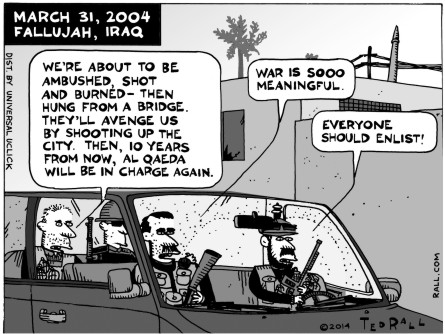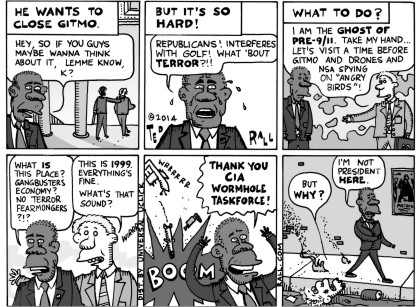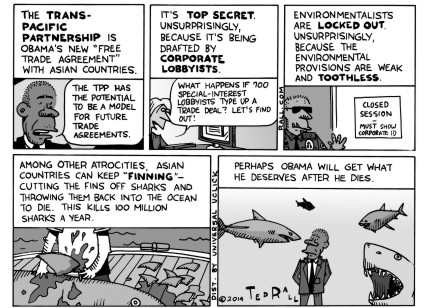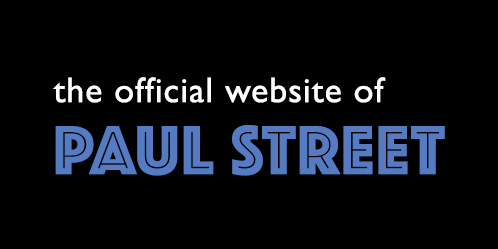Z Magazine, March 2014. According to a global survey of 66,000 people conducted across 68 countries by the Worldwide Independent Network of Market Research (WINMR) and Gallup International at the end of 2013, Earth’s people see the United States as the most significant threat to peace on the planet. The U.S. was voted top threat by a wide margin, receiving 24 percent of the vote. Pakistan was a distant second with 8 percent, followed by China (6 percent). Afghanistan, Iran, Israel, and North Korea tied for 4th place at 4 percent. Among U.S.-allied countries, Greece and Turkey (45 percent each), Pakistan (44 percent) and Mexico (about 37 percent) believed the U.S. is the greatest threat to peace.
This poll was met with deafening silence across the dominant U.S. corporate and so-called mainstream media. It did not receive a single mention in the New York Times, the Washington Post, the Wall Street Journal, the Chicago Tribune, or the Los Angeles Times. It was not considered worthy of reportage on the nightly news at NBC, CBS, ABC, or PBS. It barely registered in the U.S. mass media, receiving at most short and dismissive treatment on the margins of serious news and commentary.
Typical of that dismissal was an International Business Times headline that questioned the validity and/or rationality of the finding. “In Gallup Poll,” the headline read, “Leading Threat to World Peace is…America?” The implication was clear in the IBR article that the world’s opinion was absurd (IBT, January 2, 2014)
Editors at the right-wing New York Post responded with literally world-weary disgust at those who just “don’t like the U.S.,” even after Barack Obama became president. Noting a 2006 Gallup poll in which world citizens said that “Washington [w]as a bigger threat to world peace than Teheran” (a self-evidently ridiculous belief as far as the Post was concerned), those editors commented that, “In 2008, President Obama would…campaign about how Bush’s policies had harmed America’s standing in the world, at one point suggesting that attitudes in the Muslim world would be transformed simply by his election.
“It hasn’t turned out that way, as these Gallup numbers suggest. Maybe we’d do better to accept the real message of all these global surveys: There are many people in this world who don’t like the U.S. and will regard us as a threat no matter who’s president” (New York Post, January 5, 2014).
 For any serious and honest observer of U.S. foreign policy and the international scene today and for many decades, the United States’ longstanding and persistent (“even” under Obama) status as the leading menace to peace in the world’s eyes should be anything but surprising. The U.S., after all, accounts for nearly half the world’s military spending. It maintains more than 1,000 military installations across more than 100 “sovereign” nations spread across every continent.
For any serious and honest observer of U.S. foreign policy and the international scene today and for many decades, the United States’ longstanding and persistent (“even” under Obama) status as the leading menace to peace in the world’s eyes should be anything but surprising. The U.S., after all, accounts for nearly half the world’s military spending. It maintains more than 1,000 military installations across more than 100 “sovereign” nations spread across every continent.
The Obama administration deploys Special Operations forces in 75 to 100 countries (up from 60 at the end of the George W. Bush administration) and conducts regular lethal drone attacks against officially designated terrorists (and a much larger number of innocent civilians) in the Middle East, Southwest Asia and Africa. It maintains a massive global surveillance program dedicated to the elimination of privacy on Earth—a program that has spied even on the personal cell phones of European heads of state, including Germany’s Angela Merkel. As Der Speigel, Germany’s leading newspaper noted in 1997: “Never before in modern history has a country dominated the earth as totally as the United States does today…. America is now the Schwarzenegger of international politics: showing off muscles, obtrusive, intimidating…. The Americans, in the absence of limits put to them by anybody or anything, act as if they own a kind of blank check.”
An “Aerial Traffic Jam” Above a “One-Sided Slaughter” (Iraq, 1991)
Perhaps Der Spiegel’s editors were thinking of U.S. conduct in Iraq when they penned those lines. They may have reflected on the “Highway of Death,” when U.S. forces massacred tens of thousands of surrendered Iraqi troops retreating from Kuwait on February 26 and 27, 1991. The Lebanese-American journalist Joyce Chediac testified that: “U.S. planes trapped the long convoys by disabling vehicles in the front, and at the rear, and then pounded the resulting traffic jams for hours. ‘It was like shooting fish in a barrel,’ said one U.S. pilot. On the sixty miles of coastal highway, Iraqi military units sit in gruesome repose, scorched skeletons of vehicles and men alike, black and awful under the sun…for 60 miles every vehicle was strafed or bombed, every windshield is shattered, every tank is burned, every truck is riddled with shell fragments. No survivors are known or likely…. ‘Even in Vietnam I didn’t see anything like this. It’s pathetic,’ said Major Bob Nugent, an Army intelligence officer…. U.S. pilots took whatever bombs happened to be close to the flight deck, from cluster bombs to 500 pound bombs…. U.S. forces continued to drop bombs on the convoys until all humans were killed. So many jets swarmed over the inland road that it created an aerial traffic jam, and combat air controllers feared midair collisions…. The victims were not offering resistance…it was simply a one-sided massacre of tens of thousands of people who had no ability to fight back or defend.” (Ramsey Clark et al., War Crimes: A Report on United States War Crimes Against Iraq to the Commission of Inquiry for the International War Crimes Tribunal, testimony of Joyce Chediac).
Less than a year after his forces inflicted this unthinkable carnage, U.S. President George H.W. Bush proclaimed that, “A world once divided into two armed camps now recognizes one sole and pre-eminent power, the United States of America. And they regard this with no dread. For the world trusts us with power, and the world is right. They trust us to be fair and restrained. They trust us to be on the side of decency. They trust us to do what’s right” (Blum, Rogue State).
No Cruelty Too Great
The mass-murderous “turkey-shoot” conducted by the forces of “decency” in 1991 was consistent with the United States’ long record of savage imperial violence. That history stretches from the bloody extermination of the nation’s original inhabitants (the long Native American holocaust of 1607-1890) through the racist butchering of tens of thousands of Filipinos between 1899 and 1902 (when U.S. soldiers engaged in the slaughter wrote home to friends and relatives about how they had vowed to fight “until the niggers are killed off like Indians”), the arch-criminal and unnecessary atom-bombing of Japan, and the U.S. “crucifixion of Southeast Asia” (Noam Chomsky’s term for a U.S. policy that liquidated more than 4 million Indochinese—regularly labeled “gooks” and other racist names by U.S. troops—between 1962 and 1975).
Perhaps Der Spiegel’s editors were also reflecting on economic sanctions and U.S. Secretary of State Madeline Albright. Five years after “the Highway of Death,” Albright told CBS News’ Leslie Stahl that the death of half a million Iraqi children due to U.S.-imposed economic sanctions was a “price…worth paying” for the advancement of inherently noble U.S. goals. “The United States,” Secretary Albright explained three years later, “is good. We try to do our best everywhere.”
This, too, was nothing new. As Chomsky noted in 1992, reflecting on U.S. efforts to maximize suffering in Vietnam by blocking economic and humanitarian assistance to the nation it had devastated after the Vietnam War ended: “No degree of cruelty is too great for Washington sadists. The educated classes know enough to look the other way” (Noam Chom- sky, What Uncle Sam Really Wants, 1992).
Sons and Daughters
The imperial sadism has continued into the current millennium. The world’s “Schwarzenegger” since September 11, 2001 has gone off on a rampage, killing, maiming, and displacing millions across the Muslim World as part of its Global War on/of Terror (GWOT).
 In a foreign policy speech he gave on the eve of announcing his candidacy for the U.S. presidency in the fall of 2006, then-U.S. Senator Barack Obama had the audacity to say the following in support of his claim that U.S. citizens supported “victory” in Iraq: “The American people have been extraordinarily resolved. They have seen their sons and daughters killed or wounded in the streets of Fallujah” (Barack Obama, “A Way Forward in Iraq,” Chicago Council on Global Affairs, November 20, 2006).
In a foreign policy speech he gave on the eve of announcing his candidacy for the U.S. presidency in the fall of 2006, then-U.S. Senator Barack Obama had the audacity to say the following in support of his claim that U.S. citizens supported “victory” in Iraq: “The American people have been extraordinarily resolved. They have seen their sons and daughters killed or wounded in the streets of Fallujah” (Barack Obama, “A Way Forward in Iraq,” Chicago Council on Global Affairs, November 20, 2006).
It was a spine-chilling selection of locales. Uncle Sam’s 21st century cruelty peaked, perhaps, in Fallujah, Iraq, in 2004. The ill-fated city was the site of colossal U.S. war atrocities, crimes including the indiscriminate murder of thousands of civilians, the targeting even of ambulances and hospitals, and the practical leveling of an entire city by the U.S. military in April and November.
By one account: “The U.S. launched two bursts of ferocious assault on the city, in April and November of 2004… [using] devastating firepower from a distance which minimizes U.S. casualties. In April….military commanders claimed to have precisely targeted…insurgent forces, yet the local hospitals reported that many or most of the casualties were civilians, often women, children, and the elderly…[reflecting an] intention to kill civilians generally…. In November…[U.S.]aerial assault destroyed the only hospital in insurgent territory to ensure that this time no one would be able to document civilian casualties. U.S. forces then went through the city, virtually destroying it. Afterwards, Fallujah looked like the city of Grozny in Chechnya after Putin’s Russian troops had razed it to the ground” (Michael Mann, Incoherent Empire N ew York, 2005).
U.S. deployment of radioactive ordnance (depleted uranium) in Fallujah also helped create a subsequent epidemic of infant mortality, birth defects, leukemia, and cancer there. But, of course, Fallujah was just one especially graphic episode in a broader arch-criminal invasion that led to the premature deaths of at least one million Iraqi civilians and left Iraq “a disaster zone on a catastrophic scale hard to match in recent memory” (Tom Engelhardt, Tom Dispatch.com, January 17, 2008). According to the respected journalist Nir Rosen in December 2007, “Iraq has been killed…the American occupation has been more disastrous than that of the Mongols who sacked Baghdad in the thirteenth century” (Current History, December 2007).
“So You Stuff ’Em in Guantanamo”
Lawrence Wilkerson is a former combat officer and onetime chief of staff to George W. Bush’s Secretary of States Colin Powell. Speaking to investigative journalist Jeremy Scahill, he described a typical Special Forces operation during the occupation of Iraq: “You go in and you get some intelligence…and you say ‘Oh, this is really good actionable intelligence. Here’s ‘Operation Blue Thunder. Go do it.’ And they kill 27, 30, 40 people, whatever, and they capture seven or eight. Then you find out that the intelligence was bad and you killed a bunch of innocent people and you have a bunch of innocent people on your hands, so you stuff ’em in Guantanamo. No one ever knows anything about that….you say, ‘chalk that one up to experience,’ and you go on to the next operation” (J. Scahill, Dirty Wars: The World is a Battlefield).
Anyone who thinks U.S. imperial savagery came to some kind of a merciful halt with the ascendency of Barack Obama to the White House is living in a dream world. Obama may have been tasked with winding down Washington’s failed ground wars in Iraq and Afghanistan, but he has drastically expanded the scale, intensity, and scope of the drone war and the presence of Special Forces troops around the world. Obama, as the courageous journalist Allan Nairn noted early on, has kept the giant U.S. imperial “machine set on kill” (Democracy Now!, January 6, 2010).
The tone was set from the start, with Obama signing off on two major drone strikes in Pakistan on his fourth day in office. The first strike “killed between seven and fifteen people, nearly all of them civilians.” The second one “struck the ‘wrong house’ and killed five to eight civilians,” including two children. Less than half a year later, another one of Obama’s “signature [drone] strikes” targeted a funeral and killed “scores of civilians—estimates ranged between 18 and 55.” By October 2009, Scahill reports, “Obama had already authorized as many drone strikes in ten months as Bush had in his entire eight years in office.”
 A military source told Scahill about a standard Special Forces kill operation in the Age of Obama: “If there’s one person they’re going after and there’s thirty-four [other] people in the building, then thirty-five people are going to die.”
A military source told Scahill about a standard Special Forces kill operation in the Age of Obama: “If there’s one person they’re going after and there’s thirty-four [other] people in the building, then thirty-five people are going to die.”
An illustrative incident in the U.S. war on/of terror occurred in the first week of May 2009. That’s when U.S. air-strikes killed more 140 civilians in Bola Boluk, a village in western Afghanistan’s Farah Province. Ninety-three of the dead villagers torn apart by U.S. explosives were children. Just 22 were males 18 years or older. As theNew York Times reported: “In a phone call played on a loudspeaker on Wednesday to…the Afghan Parliament, the governor of Farah Province, Rohul Amin, said that as many as 130 civilians had been killed, according to a legislator, Mohammad Naim Farahi…. The governor said that the villagers have brought two tractor trailers full of pieces of human bodies to his office to prove the casualties that had occurred…. Everyone was crying…watching that shocking scene.’ Mr. Farahi said he had talked to someone he knew personally who had counted 113 bodies being buried, including…many women and children” (NYT, May 6, 2009).
The initial response of the Obama Pentagon to this horrific incident—one among many mass U.S. aerial civilian killings in Afghanistan and Pakistan beginning in the fall of 2001—was to blame the deaths on “Taliban grenades.” Obama’s Secretary of State Hillary Clinton expressed “regret” about loss of innocent life, but the Administration refused to issue an apology or to acknowledge U.S. responsibility. By contrast, Obama had just offered a full apology and fired a White House official for scaring New Yorkers with an ill-advised Air Force One photo-shoot flyover of Manhattan that reminded people there of 9/11 (New York Daily News, April 28, 2009; Los Angeles Times, May 9, 2009).
The disparity was remarkable: frightening New Yorkers led to a full presidential apology and the discharge of a White House staffer. Killing more than 100 Afghan civilians did not require any apology. Nobody had to be fired. And the Pentagon was permitted to advance preposterous claims about how the civilians perished—stories that were taken seriously by corporate media. The U.S. subsequently conducted a dubious “investigation” of the Bola Boluk slaughter that slashed the civilian body count and blamed the Taliban for putting civilians in the way of U.S. bombs.
“Peace prize? He’s a killer.” Thus spoke a young Pashtun man to an Al Jazeera English reporter on December 10, 2009—the day Obama was given the Nobel Peace Prize. “The man spoke from the village of Armal, where a large crowd gathered around the bodies of twelve people, one family from a single home, all killed by U.S. Special Forces during a late-night raid. ”
Top Threat to Livable Ecology
The U.S. is not the top menace only to peace on Earth. It is also the leading threat to personal privacy (as has been made clearer than ever by the Snowden revelations), to democracy (the U.S. funds and equips repressive regimes around the world) and to Earth itself—to a livable global natural environment. Regarding climate change, which poses an ever more imminent threat of human extinction, Washington delights now in blaming China. China, the U.S, says, is now the major culprit behind climate change, since its carbon emissions having more than doubled since 2001 and it now spews more carbon into the atmosphere than any other nation.
This is a smokescreen designed to cloak the United States’ primary culpability for the monumental wrong of petro-capitalist-ecocide—a transgression that will dwarf all previous crimes if allowed to run full its exterminist course. The U.S. remains far and away the world’s largest carbon-emitter on a per-capita basis. Individual U.S. citizens generate an average of 20 tons of carbon emission per year, nearly 4 times the rate of the average Chinese citizen. No nation has spewed more accumulated carbon into Earth’s atmosphere in the industrial era than the United States—an historical reality that neither China nor India will breach anytime soon
No nation has invested more heavily and powerfully in the political, ideological, and military promotion and defense of the at once carbon- and growth- addicted profits system than the United States. The U.S. is headquarters of the corporate carbon-industrial-complex’s giant lobbying and propaganda war on the increasingly dire findings of modern climate science—including those of NASA.
No national government has done more to deep-six increasingly desperate international efforts to reduce global carbon emissions than that of the United States—a record that has continued with depressing vengeance through the supposedly “green” Obama presidency.
And the U.S. investor class leads the world when it comes to global investment in the fossil fuel industry. While most of the world’s new coal plants are being built in China and India, much of the financing comes from Wall Street. Since 2006, for example, J.P. Morgan Chase has invested $17 billion in new coal plant construction abroad. Citbank added $14 billion during the same period (P. Gaspar, International Socialist Review, January 2013). As Sadie Robinson wrote in England’s Socialist Worker, “Simply looking at China’s emissions as a country obscures the role that the West plays in creating them. China’s rising emissions are largely due to the rapid expansion of coal-fired power stations. This is directly linked to the fact that many Western companies have effectively outsourced their emissions to China. They have rushed to open manufacturing plants in China to take advantage of lower operating costs…. And these plants are largely powered by coal…. The West has also played a role in boosting China’s emissions by using it as a cheap source of goods” (Socialist Worker UK, November 24, 2009). A recent Rolling Stone (RS) report is titled “How the U.S. Exports Global Warming” According to RS writer Tim Dickinson, “even as our nation is pivoting toward a more sustainable energy future, America’s oil and coal corporations are racing to position the country as the planet’s dirty-energy dealer—supplying the developing world with cut-rate, high-polluting, climate-damaging fuels. Much like tobacco companies did in the 1990s—when new taxes, regulations and rising consumer awareness undercut domestic demand—Big Carbon is turning to lucrative new markets in booming Asian economies where regulations are looser. Worse, the White House has quietly championed this dirty-energy trade” (RS, February 3, 2014, http://www.rollingstone.com).
All of this is consistent with a finding in a 2007 Pew Global Attitude survey. In 34 of 37 countries where the public was asked “which country has done the most to hurt the world’s environment?,” majorities or pluralities named the United States. That sentiment is certainly no less widespread—and no less accurate—in the Age of Obama than in the Bush-Cheney years. The Obama administration has worked effectively to repeatedly undermine efforts at coordinated global reduction of greenhouse as emissions. “The Obama administration wants to be seen as a climate leader, but there is no source of fossil fuel that it is prepared to leave in the ground,” says Lorne Stockman, research director for Oil Change International. “Coal, gas, refinery products—crude oil is the last frontier on this. You want it? We’re going to export it.”
Eco-cide is no small misdeed in global eyes. “Pollution and environmental” problems were identified in the 2007 Pew poll as the “greatest world danger” (above nuclear proliferation, AIDS and other infectious diseases, religious and ethnic hatred and income inequality) by the public of a large number of nations including Canada, Sweden, Spain, Ukraine, China, and India, 2007 Pew Global Attitude Survey).
“The Self Righteous Who Think They Are Without Sin”
 Could surveys like the 2013 WINMR-Gallup poll, the 2006 Gallup poll, and the 2007 Pew Global Attitudes Survey help feed a new peace movement in the U.S.? Most ordinary U.S. citizens do not wish the U.S. to be seen as a global bully and threat, indeed a mass murderous menace to global security, freedom, and survival. They are not supporters of war, empire, totalitarianism, and eco-cide.
Could surveys like the 2013 WINMR-Gallup poll, the 2006 Gallup poll, and the 2007 Pew Global Attitudes Survey help feed a new peace movement in the U.S.? Most ordinary U.S. citizens do not wish the U.S. to be seen as a global bully and threat, indeed a mass murderous menace to global security, freedom, and survival. They are not supporters of war, empire, totalitarianism, and eco-cide.
But for the reality of global opinion indicating widespread, longstanding, legitimate, and continuing fear of, the U.S. to sink in and influence mass U.S. opinion, two obstacles have to be overcome. The first is the refusal of the managers and owners of dominant U.S. mass media to seriously report on the views of people beyond U.S. borders—a reflection of U.S. policymakers’ longstanding indifference to the opinions of those over whom they have exercised power beyond U.S. shores. (Not that those policymakers care much about public opinion inside the U.S., see Paul Street, “No Functioning Democracy,” ZMagazine, September 2013).
The second is the barrier that the nationally narcissistic doctrine of an intrinsically generous and noble America poses to many U.S. citizens’ readiness to accept the notion of the U.S. as any kind of threat to world peace at all, much less the leading threat. Consider the reflections of former New York Times foreign correspondent Stephen Kinzer on the United States’ annexation of Hawaii and the Philippines, its seizure of Puerto Rico, and its overthrow of elected governments in Nicaragua and Honduras during the late 19th and early 20th centuries: “Why did Americans support policies that brought suffering to people in foreign lands? There are two reasons, so intertwined that they became one. The essential reason is that American control of faraway places came to be seen as vital to the material prosperity of the United States. This explanation, however, is wrapped inside another one: the deep-seated belief of most Americans that their country is a force for good in the world. Thus, by extension, even the destructive missions the United States embarks on to impose its authority are tolerable.
“Generations of American political and business leaders have recognized the power of the noble idea of American exceptionalism. When they intervene abroad for selfish or ignoble reasons, they always insist that in the end, their actions will benefit not only the United States but also the citizens of the country in which they are intervening and, by extension, the causes of peace and justice in the world” (Kinzer, Overthrow: America’s Century of Regime Change From Hawaii to Iraq, New York, 2006).
This problem of “American exceptionalism”—the almost religious belief that U.S. goals and behavior are inherently benevolent, well-intentioned, and good for the world—remains deeply entrenched more than a century later. It is a leading reason, along with the scale and conduct of U.S. empire, that the world’s people are correct to identify the United States as leading threat to peace on Earth. Nothing is more dangerous than a sole military Superpower that believes itself beyond moral reproach, as when presidents and presidential candidates say things like this: “We lead the world in battling immediate evils and promoting the ultimate good…. America is the last, best hope of Earth…. America’s larger purpose in the world is to promote the spread of freedom. The American moment has not passed…we will seize that moment, and begin the world anew” (U.S. presidential candidate Barack Obama, April 23, 2007).
“Our security emanates from the justness of our cause; the force of our example; the tempering qualities of humility and restraint” (U.S. President Barack Obama, Inaugural Address, January 20, 2009).
Reading such statements (long standard on the part of U.S. politicians), I am reminded of psychotherapist M. Scott Peck’s observation that “The evil in this world is committed by the…self-righteous who think they are without sin because they are unwilling to suffer the discomfort of significant self-examination…[their] most basic sin is pride —because all sins are reparable except the sin of believing one is without sin…. They are the people of the lie” (M. Scott Peck, People of the Lie: The Hope for Healing Human Evil, New York, 1983). How appropriate that the U.S. has retained its status as most dangerous nation in the world’s eyes after the passage from the more openly and clumsily imperialist Bush to the more stealthily imperial, supposedly more peace-oriented Obama.
The world, clearly, is no longer fooled by the great Obama re-branding of the “Schwarzenegger of international politics.” It properly understands the latest post- Bush president elected in the name of “hope” and “change” (watchwords of the 1992 Bill Clinton campaign) to be simply the empire’s latest new-old clothes.
The Domestic Costs and Benefits of Empire
Where might the seeds of resistance to the Empire and its malignant doctrine of American exceptionalism lie within the U.S. today? U.S. peace activists and thinkers should look particularly to the class nature of U.S. imperialism and to the question of who within the domestic power structure of the savagely unequal United States benefits most and pays the most for that imperialism. Stephen Kinzer forgot to add that “the material prosperity of the United States” is generally a nice-sounding euphemism for “the profits of the U.S. economic ruling class.”
As Chomsky noted in 1969, “There are, to be sure, costs of empire that benefit no one: 50,000 American corpses or the deterioration in the strength of the United States economy relative to its industrial rivals. The costs of empire to the imperial society as a whole may be considerable. These costs, however, are social costs, whereas, say, the profits from overseas investment guaranteed by military success are again highly concentrated in certain special segments of the society. The costs of empire are in general distributed over the society as a whole, while its profits revert to a few within” (Chomsky, For Reasons of State, Pantheon, 1972).
Chomsky’s point is no less true today when poverty is rife across the U.S. even as leading military investors enjoy unimaginable wealth amidst a “New Gilded Age” in which the 400 richest Americans possess more wealth than the entire bottom half of the U.S. population—150 million U.S. citizens—and the top 1 percent possesses as much as the bottom 90 percent.
Ultimately, however, nobody, not even the rich, can fully escape the horrific consequences of the eco-cidal growth-, waste-, and petroleum-addicted social order that the U.S. empire is sworn to protect: international capitalism. To quote the placards of environmentalists outside recent global climate summits where Obama’s representatives have prevented binding reductions in global greenhouse gas emissions: “There’s No Economy on a Dead Planet” and “There is No Planet B.”
Z
__________________________________________________________________________________________________________________________________________________________
Paul Street is the author of many books, including The Empire’s New Clothes: Barack Obama in the Real World of Power (2010) and They Rule: The 1 percent v. Democracy (Paradigm, 2014).
